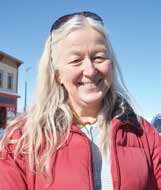Johnnie Hyde of Morse-Fall Lake First Responders and the U.S. Forest Service recently earned recognition from the National Registry of Emergency Medical Technicians for her three-decade service as an EMT and Fireline EMT. Above all, she hopes to bring recognition back to the local department and their integral role in the community.
Hyde — who came into the work while guiding for Outward Bound, where she learned wilderness medical skills — says she has “always been attracted to medicine,” and the meaning in her work comes from knowing she “helped somebody in their worst moments.”
It takes strong internal motivation to be successful in this line of work, which can be challenging and often operates on a volunteer basis.
“I never got paid for anything,” said retired first responder Kimberly Renner Bielawski. “The benefit is not financial. The compensation I got was knowing that I was able to help my neighbors.”
Some of the scenes an EMT must respond to “can really, really impact you,” said Anna Krueger. She has served on many emergency teams around the region, and now acts as a secretary and EMT for the Morse-Fall Lake department.
Echoing Hyde and Renner Bielawski, Krueger says that many EMS personnel have an internal drive that guides them into the work and through difficult moments.
“There’s something inside you,” Krueger said, “A lot of people that are new to it and join when they’re in their 30s, their 40s, their 50s — they go, you know, I’ve always wanted to do something like this. I’ve always felt like there was more I could do for my community.”
Many emergency responders share a commitment to their communities that extends beyond patient care and weaves into the fabric of life as an EMS member.
“EMS in general, you often refer to your coworkers as your brothers and sisters,” said Anna Krueger. “I feel like we really have that here in our department.”
This sense of connection among fire and medical volunteers extends across the region and the state, said Fire Chief Ted Krueger — and even nationwide for those on the frontlines of wildfires.
“People know you. Especially like Johnnie, who worked fire,” said Krueger. “I’ve been out in Arizona and somebody asked me if I knew her.”
Hyde has played a role on firefighting teams in Idaho, Washington, Oregon, Northern California, and more. She described a particular fire that occurred in North Carolina one November during the Thanksgiving holiday week.
“We got this fire under control,” Hyde said. “Six hours later, we come back to the parking lot. People had left us a full Thanksgiving dinner. Two turkeys, big pans of mashed potatoes, dressing and gravy and pumpkin pies on the hoods of our trucks.”
Mike Meskill, who worked on the Pagami Creek wildfire, also described his appreciation for the way that people can come together throughout a firefighting effort.
“I don’t want to say I enjoy a fire and then sound like a firebug, but it does get the adrenaline going. We’re a family. It’s more than just the fire department. We’re all connected,” Meskill said. “I mean, it’s a commitment to do this.”
For the department and statewide, it’s that required commitment — the training, the time given to fire and medical runs — that has created problems for volunteer EMS and fire departments statewide.
Ted Krueger said one of the greatest challenges for Morse-Fall Lake is “people just giving the time it takes” — as well as finding people who are available to answer mid-day calls.
“A lot of us have full-time jobs,” said Anna Krueger. Not everyone in the department has an understanding employer or a flexible schedule that allows them to respond at the drop of a hat.
The Morse-Fall Lake department currently has about 23 members for an area that covers 750 square miles, down from the 30 they used to have on their roster.
“Part of the problem — in my opinion — is that nobody wants to volunteer their time anymore, especially in this younger generation. Everybody wants to get paid for what they do,” said EMS Coordinator Mike Harri.
However, he said, they’ve still acquired about half a dozen young people in recent years through the EMS program at Vermilion.
EMS Coordinator Mike Harri hopes that any recognition she may receive from her award will ultimately bring attention back to the fire department as a whole and help with recruiting new volunteers.
“We’re still hoping to get a few more people on board,” Hyde said.
Anna Krueger said that skills can be taught to almost anyone. She said the most important characteristics that a prospective EMT or firefighter must bring are compassion, empathy, patience and the ability to think quickly.
“I’ve taught EMS to a huge array of different types of people with different experiences. The skills — you figure it out. The skills themselves are not hard at all,” said Krueger. “A lot of it is mental.”
“It’s a commitment,” said Meskill. “But it’s a great group. And if you do this, you’re going to be glad you did.”











